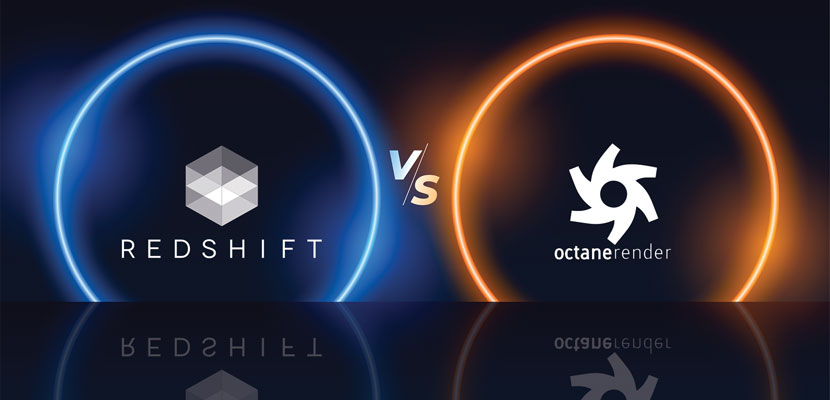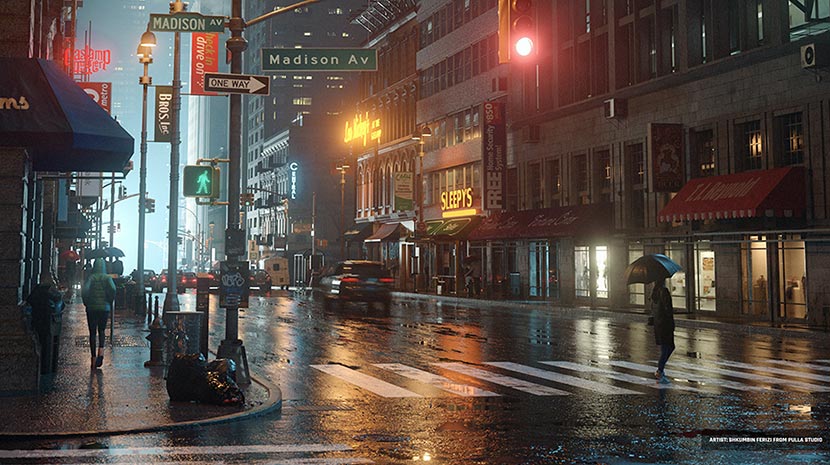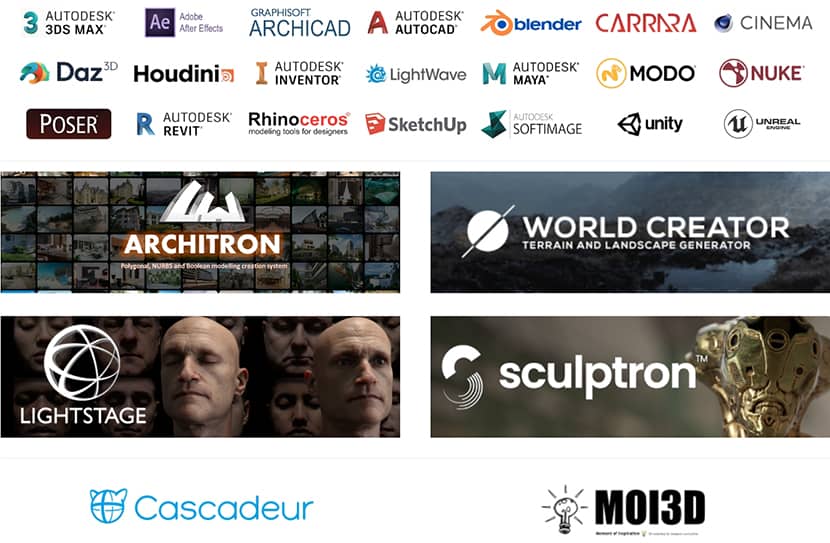
Well, we're already bored! This comparison between the several well-known render engines in our market, like Redshift and Octane, is a perceptual and widespread question that found its roots more than 20-25 years ago. Do you remember something similar? "Scanline vs. Metal Ray" for the veterans and "V-Ray vs. Corona" for the newcomers? We are sure it will go this way for the following decades, even if we speak of CPU, GPU, or another possible upcoming rendering technology.
What do we investigate in this article?
In this article, we won't try to cover the topic epidermically, summarizing with another "cliché" conclusion like: "Render engines are just tools in artists' hands. Thank you very much for reading!". We know they are, but the word JUST is the one that bothers us the most.
It must be something more than this, and to prove it, we are going to dig deeply into the net and quote you whatever information we believe can give you a clear idea of which tool is the right one for you. To do that, we must first learn and understand a few things about Cinema 4D software.
Before we jump into the article, keep in mind, that no matter what software or renderer you use, the RebusFarm Render Farm is always here to speed up your renderings. We support all 3D software, so check it for free and do not let slow rendering slow you down.
What is Maxon Cinema 4D?
According to the official Cinema 4D website, we refer to a potent yet easy-to-learn 3D modeling, animation, and rendering tool. It is a perfect package for all 3D artists who wish to create stunning results quickly and easily. All visualization artists, beginners, and professionals can benefit from Cinema 4D's broad set of features and tools to achieve outstanding results quickly. Its renowned reliability makes Cinema 4D ideal for demanding, fast-paced 3D production.

Cinema 4D Render by Bernd Montag.
On Maxon's website, you will find a bunch of Cinema 4D features. Some of the most important are below:
| Polygonal Modeling | Parametric Modeling | Volume Modeling |
| Sculpting | Poly Pen | Polygon Reduction |
| Texturing | Node-Based Materials | BodyPaint 3D |
| UVs | Animation Basics | Character Animation |
| Fields System | Magic Bullet Looks | Car Rig |
| Bullet Dynamics | Lighting | Tracking |
To get an overview of the complex Cinema 4D software, here's one of the best video presentations we found on YouTube, made by InspirationTuts channel. It is pretty short but very informative, and it deserves your time if you're not experienced with this excellent 3D software.
Which is the best render engine for Cinema 4D?
We will now focus more on comparing Redshift and Octane. The truth is that both offer speed and quality to their users, but remember that renderers don't work alone. They buckle on core software like a good extender that allows you to use the best natural system for lighting, materials, and several effects. In a few words, they are similar to what paints are for painters, and when you have an excellent raw material, you can create good things.
Cinema 4D is compatible with several render engines, such as Octane, Redshift, Arnold, V-Ray, or Corona Renderer. Nevertheless, it has two built-in render engines: the "Advanced Renderer" and the "Physical Renderer", which can render fast and give artists attractive results. Honestly, it is hard to say which is the best, even if you get advice from artists who use and have enough experience with both. Additionally, we must not forget that everyone has a personal opinion and standards. Now, it's time to investigate each renderer independently, and after that, we'll try to make a complete comparison that will help you get a clear view of the best option for you.
Redshift - The world's first fully GPU-accelerated, biased renderer
Redshift was initially developed by California-based Redshift Rendering Technologies Inc. and debuted in 2014 as a biased production renderer designed to utilize NVIDIA GPUs. It provides granular control over what is reflected and refracted in your scene at render time and uses techniques to concentrate samples in areas that need them most selectively.
In 2019, it was acquired along with all rights to its software product by the German 3D software company Maxon, the developer of Cinema 4D. That means it is now included with a Cinema 4D subscription, and this is something really crucial when users have to decide which render engine to select to enhance their Cinema 4D workflow, as they don't need to pay extra money for the subscription of another render engine. But is this finally so important for an artist to select Redshift? We'll analyze this later in the article.

Redshift Render by Shkumbin Ferizi.
According to the official Maxon website, Redshift is a powerful GPU-accelerated renderer built to meet the demands of contemporary high-end production rendering. Tailored to support creative individuals and studios of every size, it offers robust features to its users and integrates with industry-standard CG applications.
The software's biased approach doesn't waste samples on less critical regions. This optimization often allows it to deliver clean renders much faster than unbiased methods. Images may not be physically accurate, but the speed and quality trade-off is welcomed when deadlines are tight.
Some of the key features are:
| CPU+GPU hybrid rendering | Biased rendering optimization | Complex material support |
| Physically based shaders | Global illumination | Several lighting types |
| Adaptive sampling | Motion blur | AI denoising |
| Distributed rendering network | Cryptomatte rendering |
If you want to have a good first overview and follow a simple video tutorial with files included, then we suggest you check out the following video tutorial by the School of Motion channel.
Below you can check the costs according to the package you select in 2024.
Octane - The fastest, unbiased GPU renderer
According to the official Otoy website, OctaneRender® is the world's first and fastest unbiased, spectrally correct GPU render engine, delivering quality and speed unrivaled by any production renderer on the market.
OctaneRender® Studio+ subscriptions allow artists and studios full access to OTOY's acclaimed OctaneRender VFX software and ecosystem with unlimited network rendering (10+ nodes) and offline rendering support.
The software was launched in 2010 as the first commercially unbiased GPU renderer, and its technology is well-known as path-tracing. In version 2022.1, the Octane team introduced a new photon tracing kernel that uses a combination of GPU photon mapping and path guiding, securing physical lighting performance while reducing render times but keeping image quality at high standards.
Some of the key features are:
| GPU Renderer | Spectral rendering pipeline | Unbiased path tracing |
| Metallic/roughness workflows | Physically Based Uber materials | Volumetric Lighting Effects |
| Displacement and sub-surface scattering | Interactive viewport preview | AI denoising |
| Scalable across multiple GPUs | Distributed GPU network rendering |
The unbiased technology offers astonishing quality that all users don't hesitate to mention very often in the forums. Raw renders by experienced users look ready for delivery with slight or no tweaking in post-production.
Below, you can explore the Octane pricing in 2024.
Includes access to the complete OctaneRender DCC plug-in ecosystem and cloud rendering services:
If you want to get an overview of all Octane Renderer features check their website.
Redshift vs. Octane: The Final Comparison
We strongly recommend you watch this deep-dive video presentation by Theo, who nicely explains why he switched in 2020. Watching videos like this gives some guidance on what to look out for. The intricacies of every software will naturally lead to one software being superior to the other in certain areas, and obviously, we may never find the perfect software. Theo successfully resembles Octane Renderer as a hummer that is a simple, solid tool and can do the job significantly. On the other hand, he resembles Redshift as an electric screwdriver that needs more expertise and knowledge of settings to do things properly, but it also rocks.
When we read and watch comparisons on the web, it's extremely important to spend an enormous amount of time reading the comments and critiques from other readers or viewers, that work like an accurate poll, which is usually challenging to find on the topic we're looking for.
So, after all this research, which took us so many hours to finalize, and answering which render engine, Redshift or Octane, could enhance your workflow the best, we would state:
- Octane looks more exact because it gets unbiased lighting, while Redshift lets you define it.
- Octane is really fast. Everyone says that, and there is no doubt, but it can't handle volumetrics that well.
- It's easier for novice users to achieve decent results in Octane versus the learning curve of mastering a biased engine like Redshift.
- For personal and small studio use, Octane is an excellent choice with affordable prices.
- There are fields, such as concept art, where most artists use Cinema 4D & Octane workflow. For that reason, it is painful for someone to switch, as there is no subject of easy collaboration when you're using different tools from your colleagues.
- Octane's lack of biasing does mean longer render times for complex scenes.
- The Dirt node in Octane is more potent than Redshift's curvature.
- Round edges in Octane are better than in Redshift.
- The Random Color node in Octane is more reliable than Redshift's Color user data node with "Geometry ID color" when you don't want to use a Mograph effector to distribute colors on objects.
- The Render pass system of Octane is more powerful than Redshift but lacks modifiability.
- Octane's emission system is so much more potent than Redshift. With this emission channel, any polygon object can interact with volume objects as a light source.
- Redshift is obviously more complicated to learn. If you are getting better results in Octane, it could be due to a lack of knowledge in Redshift.
- Redshift could beat Octane for SSS material.
- There's a reason why Maxon acquired Redshift, and many big studios use Redshift for production nowadays.
- Scaling performance across multiple GPUs can also be less efficient in Octane than in Redshift.
- Redshift could show almost all the color output nodes' solo results quickly and correctly. That's vital when adjusting the roughness map, bump map, etc. Octane's node solo function isn't that handy, even causing software crashes sometimes.
- With the Redshift environment object, achieving the fog/god-ray effect is much easier, and the render speed is fairly fast.
- Simulating the Tyndall effect in Octane is hard because it doesn't have the "spread" attribute in a light object as Redshift does.
- In Redshift, the most frequent node we can use except "Ramp" is "ColorLayer". It composites up to 7 textures together, just like we can do in Photoshop and ONE node. It's so convenient and powerful. To do that in Octane is really complicated, involving lots of nodes.
Redshift vs. Octane: Our Truth
Well, aiming to be honest and not with a politically correct answer to the central question of this article: "Which Enhances Cinema 4D Workflow The Best?" we firmly believe that Octane is clearly the winner if we had to select a GPU render engine to work with Cinema 4D. It is also true that most artists, especially beginners, consider the extra cost for Octane's subscription, but the prices are very fair, and the tool is much easier. So, considering on a long-term basis and the time you can save due to its simplicity, we dare to say that Octane is finally cheaper than Redshift.
Last but not least, it deserves to be mentioned that in the 3D art field, there are three types of artists. The entirely creative minds, the intermediate minds, and the entirely technical minds. From all this deep research, the first two types should select Octane without a second thought, as it offers them what they are looking for. Technical minds usually love experimenting with many different tools and finally creating a description for their project that looks like an ancient Egyptian long papyrus full of software and plugins. They love to solve all kinds of problems, like searching for solutions when others give up, and that's definitely a characteristic that could make them select a more complicated tool like Redshift.

Author
Vasilis Koutlis, the founder of VWArtclub, was born in Athens in 1979. After studying furniture design and decoration, he started dedicating himself to 3D art in 2002. In 2012, the idea of VWArtclub was born: an active 3D community that has grown over the last 12 years into one of the largest online 3D communities worldwide, with over 160 thousand members. He acquired partners worldwide, and various collaborators trusted him with their ideas as he rewarded them with his consistent state-of-the-art services. Not a moment goes by without him thinking of a beautiful image; thus, he is never concerned with time but only with the design's quality.



